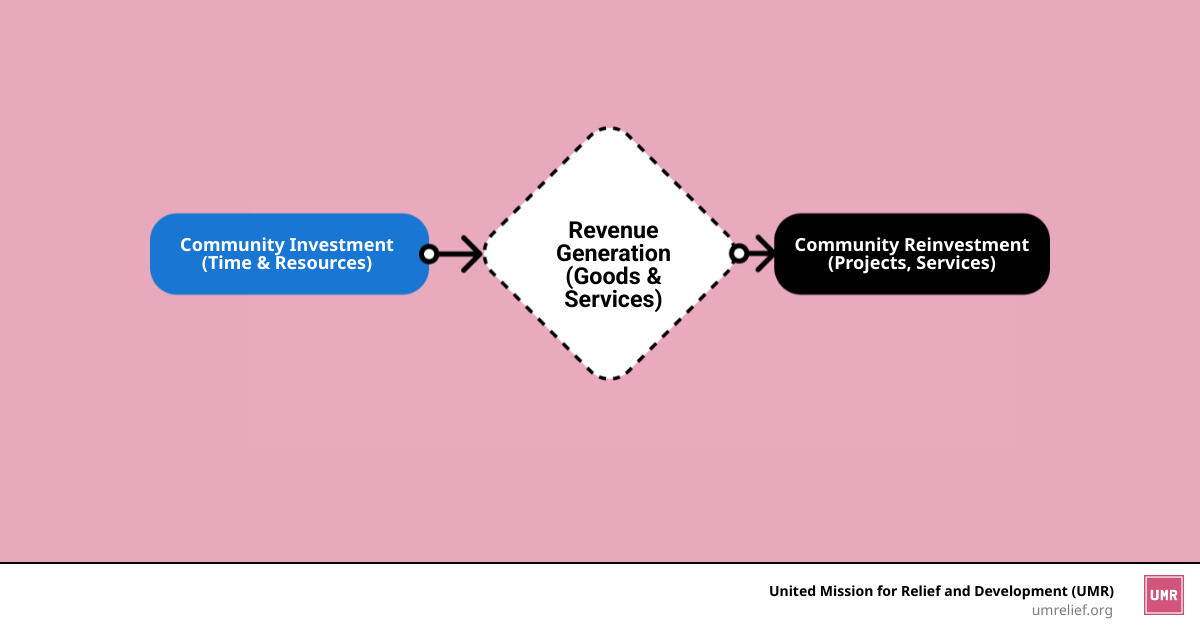Community Based Enterprises: Driving Impact 2025
Why Community-Based Enterprises Are Changing Local Development
Community based enterprises are businesses that use commercial activities to improve community life rather than generate private profit. Unlike traditional businesses, these enterprises are owned and controlled by the communities they serve, with profits reinvested into local projects and services.
Quick Answer: What Are Community-Based Enterprises?
- Purpose: Community benefit over private gain
- Ownership: Assets belong to the community, not individuals
- Leadership: Local stakeholders play leading roles
- Profits: Reinvested in community development projects
- Scale: Can generate more jobs than micro-enterprises
- Examples: Community-owned stores, cooperative farms, local energy projects
Community based enterprises are a powerful alternative to traditional business models, often emerging from collective action to address challenges like poverty and service gaps. They offer communities a path to financial self-sustainability while tackling local social and environmental problems.
The model has proven particularly effective in rural and remote areas where traditional businesses may not be viable. From Bangladesh’s organic compost entrepreneurs to New Zealand’s Māori-owned enterprises, CBEs are reshaping how we think about business and development.
Through UMR’s work, we’ve witnessed how community-based enterprises transform lives by creating sustainable economic opportunities. These ventures keep wealth and decision-making power within local communities, and our experience shows they can scale their impact while remaining true to their community-centered mission.
What is a Community-Based Enterprise (CBE)?
When we think about what makes a business truly special, it’s not always about the bottom line. A community-based enterprise (CBE) flips the traditional business script by putting community benefit at the heart of everything it does, rather than maximizing private profit for individual owners or shareholders.
While most businesses ask “How can we make money?” community based enterprises ask “How can we make our community stronger?” This refreshing approach is gaining momentum because it works. CBEs are committed to financial self-sustainability, generating their own revenue by selling goods or services just like any other business. The magic happens when profits are reinvested back into the community.
This creates a “community wealth multiplier effect.” Every dollar earned stays local, funding everything from better schools to improved healthcare to job training programs. The principles of CBEs are explored by scholars like Professor Ana María Peredo in her work on social and inclusive entrepreneurship, which highlights how these enterprises advance social justice and create diverse economic models.
Key Characteristics of a CBE
What separates a true community-based enterprise from other business models comes down to five core characteristics that ensure the community stays in the driver’s seat.
Community-owned assets form the foundation. Buildings, equipment, and other assets belong to the community collectively, not to individuals. This prevents assets from being sold off for quick cash, leaving the community empty-handed.
Community-led management ensures that daily decisions are made by people who understand local needs. Local stakeholders take charge of operations because they know the context better than anyone.
Community-controlled governance is where democracy meets business. Community members have real voting power, often based on a “one person, one vote” principle rather than being tied to investment size.
Reinvestment of surpluses is perhaps the most defining feature. When a CBE makes a profit, it gets reinvested into expanding the business, creating more jobs, or funding community projects.
Accountability to the community means these enterprises measure success differently. While financial viability is necessary, they are also judged on their social, environmental, and cultural impact. This accountability creates a cycle where the more the enterprise serves the community, the more the community supports it.
CBEs vs. Other Business Models: A Clear Distinction
It’s helpful to understand how community-based enterprises fit into the broader business landscape. While they might seem similar to other models, their unique approach to ownership, purpose, and profit makes them stand out.
A traditional private enterprise exists to make money for its owners. A micro-enterprise, like a small family shop, focuses on providing a living for the proprietor. But a community-based enterprise is designed from the ground up to benefit the entire community it serves.
| Attribute | Community-Based Enterprise (CBE) | Traditional Private Enterprise | Micro-Enterprise | Social Enterprise |
|---|---|---|---|---|
| Primary Goal | Community benefit (social, environmental, economic) | Maximize private profit for owners/shareholders | Basic living/private profit for proprietor | Social/environmental mission, then profit |
| Ownership | Community, collective, member-based | Individual, partners, shareholders | Usually single proprietor/family | Varies (non-profit, for-profit, co-op) |
| Profit Distribution | Reinvested in community/business for social mission | Distributed to owners/shareholders | Privately accumulated by owner | Majority reinvested in social mission |
| Control | Community-led and governed | Owner/management-led | Owner-led | Mission-led, may have diverse governance |
| Typical Scale | Potential for larger scale, job generation | Varies, can be very large | Small-scale, vulnerable, limited job generation | Varies, can be small or large |
| Accountability | To the community served | To owners/shareholders | To owner | To mission and stakeholders |
The scale difference is important. While micro-enterprises often struggle with limited resources, community-based enterprises can grow larger and create more sustainable employment, building economic strength for entire communities. Instead of profits flowing to distant shareholders, financial gains circulate back into the local economy, creating a positive cycle of success.
How CBEs Differ from Social Enterprises
Community-based enterprises are a specific type of social enterprise, but with key distinctions. Both models believe business can be a force for good, prioritizing a social mission and reinvesting earnings.
The key difference lies in ownership and control. While a social enterprise can be owned by anyone, a community-based enterprise puts the community firmly in the driver’s seat. The people who benefit from the enterprise are also the ones who own it and make crucial decisions.
Geographic focus is another distinguishing factor. Social enterprises can operate on a national or even global scale, while community-based enterprises are inherently local. They are rooted in a specific place, serving a defined community. This distinction matters because it ensures that the people who need help most are the ones with the power to shape how that help is delivered.
Building Successful Community-Based Enterprises
Creating a community-based enterprise is both thrilling and challenging. Success starts with careful planning, bringing people together, choosing the right structure, and finding the funding to make your vision a reality. At UMR, we’ve seen communities transform when they have the tools to build sustainable enterprises.
Choosing the Right Legal Structure
Your legal structure is the skeleton of your CBE, determining how decisions are made and who has control. The Government of Canada provides an overview of corporate structures, but it’s always best to consult with legal and tax professionals.
- Sole proprietorship: One person owns and controls everything. It’s simple to set up but offers no personal liability protection and doesn’t fit the community ownership model well.
- Partnerships: Two or more people or groups run the business together. They are flexible but share all decisions, profits, and risks.
- Business corporation: A separate legal entity that protects owners from business debts. Social goals can be built into the incorporation documents, and some pursue B Corp certification to prove their social and environmental commitment.
- Not-for-profit corporations: Exist for community benefit, not private gain. They can run profitable businesses, but all money must go back into the mission.
- Co-operatives: Democratically owned and operated by members, often with a “one member, one vote” rule. This structure is a natural fit for many CBEs, as it’s designed to serve its members and the wider community.
Securing Funding and Support for your Community-Based Enterprise
Money is often the biggest hurdle, but funding options for community-focused businesses are growing.
- Government funding: Canada’s Business Benefits Finder is a useful tool for finding grants and support.
- Social finance loans: Organizations like the Community Business Development Corporation offer loans to businesses that prioritize social impact.
- Impact investing: These investors seek both financial returns and measurable community benefit, a perfect match for a well-run CBE.
- Community bonds: Allow local residents to invest directly in your project, keeping ownership and returns within the community.
- Philanthropic grants: Foundations and charities, like UMR, are crucial sources of seed funding for livelihood initiatives that can grow into CBEs.
A solid business plan that shows both your social mission and your path to financial sustainability is key to securing any funding.
The Role of the Social Purpose Entrepreneur
Behind every successful CBE is often a social purpose entrepreneur with business skills and a community-focused heart.
- Vision and leadership: They spot gaps in the community and inspire others with a vision for how a business can fill them.
- Mobilizing the community: They bring people together, build consensus, and ensure everyone feels heard and valued.
- Business planning and management: They ground the mission in reality with sound financial planning and day-to-day management.
- Measuring social impact: They track progress to build trust with the community and attract funders who value mission alongside profit.
If you’re considering leading a CBE, you can assess your entrepreneurial potential with online tools to understand your strengths.
The Impact of CBEs: From Local Economy to Global Well-being
When community-based enterprises take root, they create waves of positive change. We’ve witnessed how these enterprises become the heartbeat of their communities—creating jobs, breathing life into local economies, and filling essential service gaps.
CBEs are powerful because they address multiple challenges at once. They weave together economic opportunity with social purpose, creating employment, strengthening the local economy by keeping money circulating, and improving well-being by fostering connections. The social cohesion that emerges is one of their most valuable impacts. As community members work toward a shared goal, trust and hope grow, making the entire community more resilient.
How CBEs Contribute to Community Needs
Because they are born from the community, community-based enterprises are uniquely positioned to tackle local problems.
- Retaining essential services: When the last grocery store or pharmacy in a town closes, a community-owned enterprise can step in, ensuring residents have access to basic needs.
- Creating employment for marginalized groups: CBEs often create jobs for people overlooked by traditional employers, offering not just a paycheck but also dignity and skills development.
- Providing affordable housing: Through community land trusts and housing co-ops, CBEs can keep housing costs reasonable and prevent long-time residents from being displaced.
- Supporting local arts and culture: Community art centers, local theaters, and craft cooperatives preserve cultural traditions and generate income for artists, enriching the lives of all residents.
- Environmental conservation projects: Community-led initiatives like composting programs or renewable energy co-ops allow neighbors to share in the environmental and economic benefits of a healthier planet.
Global Examples of Thriving Community-Based Enterprises
Around the world, inspiring community-based enterprises demonstrate how transformative this model can be.
- Artscape (Canada): This non-profit network develops affordable real estate projects for artists in Toronto, fostering vibrant cultural hubs and contributing to the city’s creative economy.
- Muntigunung Community Social Enterprise (Indonesia): In a remote, drought-plagued area, women have created a business selling high-quality handmade products, with all profits funding community water, healthcare, and education projects.
- A-Way Express (Canada): This Toronto courier company is founded and staffed by individuals with lived experience of mental health challenges, providing supportive employment and tackling stigma.
- Hikurangi Enterprises (New Zealand): A Māori-owned enterprise that develops sustainable local businesses, from sawmilling to medicinal cannabis, using local resources to strengthen community and cultural preservation.
- Organic compost enterprises (Bangladesh): With support, families have built businesses selling nutrient-rich fertilizer, increasing their household income sevenfold and inspiring neighbors to launch similar ventures.
- Village Savings and Loan Associations: These self-managed groups, popular with women, allow neighbors to save money, access small loans, and build financial literacy and social bonds without outside capital.
Overcoming Challenges and Ensuring Future Success
Running a community-based enterprise isn’t always smooth sailing. These ventures face unique problems as they balance social good with financial health. However, with the right approach and strong community support, these challenges become stepping stones to greater impact.
Thriving CBEs are set apart by their ability to plan strategically, build their team’s skills, and adapt to economic shifts. Most importantly, they maintain strong governance and keep their community engaged every step of the way.
Common Challenges Faced by CBEs
- Access to capital: Traditional banks often struggle to evaluate businesses that prioritize community benefit over maximum profit.
- Balancing social mission with financial viability: It’s a constant juggling act to meet financial obligations without losing sight of the core community-focused mission.
- Management and technical skills gaps: Passionate community members may need support with business functions like bookkeeping, marketing, or other technical skills.
- Scaling operations: Growing too fast can strain resources and dilute community control, while growing too slowly can mean missing opportunities.
- Market competition: CBEs often compete with for-profit businesses that don’t have the same social responsibilities, making it hard to match prices.
Strategies for Sustainability and Growth
- Building strong partnerships: Collaborating with local governments, schools, and other organizations provides access to expertise, resources, and networks.
- Diversifying revenue streams: Combining income from sales, fees, grants, and community investments creates financial stability.
- Investing in training and development: Ongoing education in financial literacy, marketing, and technical skills pays dividends in improved operations and confidence.
- Engaging in policy advocacy: Working together, CBEs can advocate for better policies and funding, strengthening the entire sector.
- Leveraging technology: Digital tools for accounting, operations, and marketing can improve efficiency and expand reach without being overly complex or expensive.
Conclusion: The Future is Community-Driven
Community-based enterprises are more than an alternative business model—they are a blueprint for a more equitable and sustainable world. They prove that commerce can be a powerful force for good, creating economic opportunities while tackling the social and environmental challenges that matter most to local communities.
When people have ownership and a direct stake in their local economy, profits stay local, funding schools, creating jobs, and strengthening the fabric of community life. This is the change we’ve witnessed through our work at UMR, from supporting organic compost entrepreneurs in Bangladesh to working alongside communities building their own enterprises.
These ventures build resilience in ways that traditional aid cannot. When a community owns its businesses, it becomes less dependent on external support and more capable of adapting to change. The jobs created provide not just income, but also dignity and purpose.
At UMR, our commitment to empowering communities through sustainable livelihood support stems from this understanding. We know that lasting change happens when communities have the tools to drive their own development. In all the countries we serve, from Jordan and Palestine to Kenya and Bangladesh, our approach centers on partnership, not charity.
The future we’re building is one where every community has the support it needs to create its own path to prosperity. It’s a future where local solutions address local challenges and profits serve people.
We invite you to be part of this movement. Learn more about our livelihood support programs and find out how you can help communities build the enterprises that will transform their futures.












